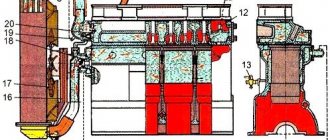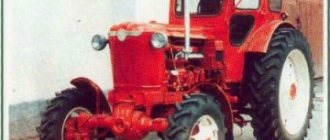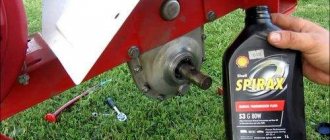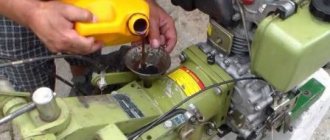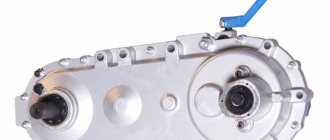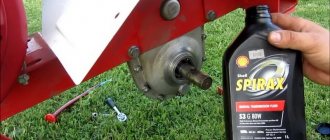An automobile gearbox is a transmission element that receives torque from the crankshaft and transmits it to the center differential. Depending on the type of transmission, there are gearboxes integrated into the gearbox of the front axle (on front-wheel drive models) and the rear axle (on rear-wheel drive models). All-wheel drive models, accordingly, have both gearboxes. Torque is transmitted through the gearbox through gears rotating at a certain frequency. To prevent their abrasion as a result of friction, gear oil is used in the gearbox.
When to change
There is no definite period for changing the oil in the gearbox. It is customary to pour new oil into the unit at the same time that other transmission elements are serviced and other transmission fluids are changed. The standard period for transmission maintenance is 45 thousand kilometers, then every 60 thousand kilometers, or every 2 years of vehicle operation.
With intensive use, the period for changing the oil in the gearbox is reduced to 30-35 thousand kilometers. These conditions include:
- transporting heavy loads, towing trailers or vehicles on a cable;
- frequent driving in city mode (start-stop);
- operation in adverse conditions (off-road, snowy roads, etc.).
The user manuals for some models indicate that the first oil change in the gearbox must be done after 1-2 thousand kilometers. The fact is that at this stage the car components undergo grinding in, which is characterized by increased friction and the formation of wear products.
How to check oil level and quality
During vehicle operation, the oil in the gearbox loses its viscosity, and subsequently oxidation processes occur as a result of the ingress of heated air due to insufficient tightness of the system. As a result, the oil decomposes and ceases to perform lubricating functions, intense wear of the gears occurs and the gearbox overheats.
Checking the quality and level of the oil is carried out on an overpass or inspection hole - it is important that the surface on which the car stands is absolutely flat. The check is carried out, as they say, “cold”, when all the oil collects in the gearbox housing.
The first step is to unscrew the filler plug using a hexagon. If after unscrewing a certain amount of oil spills out, its level in the crankcase is sufficient. If oil does not flow from the filler hole, then you can check its level by inserting a finger, stick, wire, etc. into the hole. Ideally, the oil level should be no lower than a few millimeters from the lower edge of the filler hole. If the distance is greater, then the oil level is insufficient. You can check the quality of the lubricating fluid by pumping out a small amount of oil using a syringe and assessing its appearance and consistency.
What oil to fill and how much
The gear oil recommended by the manufacturer in the user manual is suitable for filling. If there is no manual, and the car owner is not completely sure which gear oil is suitable, then you need to focus on the API classification and viscosity indicators.
All manufacturers recommend using transmission oils numbered GL-4 or GL-5 on modern cars - these are the fluids that contain the necessary extreme pressure additives. As for viscosity, the choice here depends on the climatic operating conditions. For transmission oil, it is advisable to choose all-season options - it is unlikely that anyone will change the oil in the gearbox for one season. Such products are indexed with double numbering, for example, 75W-90, where the first digit indicates viscosity at low temperatures, and the second viscosity during summer operation. The lower the first number, the lower the temperatures at which the gear oil retains its viscosity. For example, 70W oil can be used at extreme temperatures of -55 °C, 75W - at -40 °C, 80W - at -26 °C, etc.
As for the required volume, for passenger cars with a single axle drive, 1-2 liters of transmission is usually enough. For vehicles with four-wheel drive and dual sump, 3 liters or more may be required. For utility vehicles, the required volume of transmission oil can reach 10-15 liters. Before filling, it is advisable to stock up on additional volume (up to 1 liter), since additional flushing of the gearbox may be necessary.
Oil change instructions
It is advisable to change the oil after a short trip - this will allow the oil to warm up and become less viscous. To carry out the operation, it is again advisable to use a lift or inspection hole - this will make access to the gearbox easier.
- The first step is to drain the old transmission oil. To do this, unscrew the drain plug using a hexagon. Used oil must be drained into a prepared container.
- When draining, you should pay attention to the consistency and appearance of the used fluid - if there are impurities in it in the form of metal inclusions, then before filling the new transmission you will have to flush the gearbox.
- Then you need to remove the plug from the filler hole of the gearbox housing using a hexagon.
- To pump new oil into the gearbox, you can use a large medical syringe or a lever pump (grease pump).
- The gearbox must be filled with oil until it overflows. When using a grease gun, this will take 10-15 minutes; when using a syringe, it will take a little longer.
- After filling, you need to wipe off any remaining oil from the gearbox and place the filler plug on the sealant.
Replacing the oil pump drive gear on a VAZ 2106
If the “oil pressure” indicator on the instrument panel in your six constantly lights up, there may be several reasons for this. The first reason is lack of oil. If after changing the oil the indicator continues to glow, the fault is most likely in the oil pump, or rather its gears. Replacing the VAZ 2106 oil drive gear:
Replacing the oil drive gear of a VAZ 2106
- To get to this gear you need to remove the ignition distributor breaker.
- Before removing the distributor, it is necessary to set the crankshaft to the desired position.
- We unscrew the spark plug of the first cylinder.
- The hole in the first cylinder must be plugged with a finger.
- We turn the crankshaft until air comes out of the first cylinder - the beginning of the compression stroke.
- We slowly turn the crankshaft until the marks on the engine block and the crankshaft pulley coincide. After this, you can remove the distributor.
- Disconnect the wires from the breaker-distributor.
- Disconnect the vacuum regulator hose.
- Using a 13mm wrench, unscrew the nut securing the distributor.
- We remove the distributor-breaker from the cylinder block.
Removing the ignition distributor
- Next you need to remove the gear. This is done using a wooden or aluminum mandrel. It should fit snugly into the gear.
- By placing the gear on the mandrel, holding it with a screwdriver if necessary, the gear is removed.
- The new gear is inserted in place of the old one.
- Next is the assembly process. We install the distributor in its original position.
- Tighten the fastening nut with a 13mm wrench.
- We connect the wires in the order of cylinder operation 1-3-4-2 counterclockwise.
- We put on the hose of the vacuum ignition regulator.
Flushing the gearbox
To flush the gearbox, special flushing fluids are used (Loctite 7840, DS Lavado, etc.). As an alternative, you can use a mixture of gear oil (70%) and kerosene or diesel fuel (30%).
This mixture must be poured into the gearbox housing using a grease gun or syringe. Then you should hang the wheels of the drive axle using supports, start the engine and engage first gear, simulating a trip. In this mode, you need to let the engine run for 10-15 minutes, allowing the flushing mixture to clean the gearbox. After this, the mixture should be drained in the same way as used transmission oil was drained.
While changing the transmission oil in the gearbox, you can at the same time assess the condition of other parts and consumables, for example, axle seals. It is the wear of the seals that can cause the oil level in the gearbox to be low. If leaks are detected in the seals, they should be replaced with new ones.
The main task of the oil in the gearbox is to minimize the abrasion of the gears, in other words, to increase their service life. Low quality lubricants, as well as untimely replacement, have a detrimental effect on the condition of parts.
The replacement frequency is on average 50 thousand kilometers for cars with a manual transmission, and 30 thousand for an automatic one.
It is more often necessary to change the oil on cars that are used in difficult conditions, which include:
- Off-road driving;
- Constant maximum vehicle load;
- Frequent towing of cars or trailers.
In a new car, it is recommended to replace it after the first 2-3 thousand mileage. The fact is that at the initial stage of work, new components undergo the so-called “grinding in”, which is characterized by increased formation of wear products.
Many car owners change the oil in the gearbox at the same time as the manual transmission, since both units use transmission fluid.
Be sure to check the level and condition of the oil in the gearboxes after purchasing a car on the secondary market. Usually, before selling, owners change lubricants only in places where they can be easily checked. Gearboxes are not one of these.
How does the rear axle work, why does it wear out?
The rear axle gearbox (transfer case) is a unit connected to each other that transmits torque from the power unit to the wheels. The gearbox is subjected to different loads, the degree of which depends on the speed. Because of this, friction appears in it, which has a destructive effect on its condition. In order to compensate for this effect, a special lubricant is used to soften the movement of moving parts and ensure their integrity. Changing the oil in the gearbox is an important procedure that should not be neglected.
The oil in the rear axle needs to be changed approximately once every thirty-five thousand kilometers. This replacement frequency is recommended by well-known car manufacturers. There are certain signs that, if detected, must immediately replace the consumable (having previously determined what kind of oil to pour into the rear axle gearbox). These include:
- reducing the amount of motor oil;
- the appearance of gray dust in the lubricant;
- changing the shade of the consumable.
Checking the level and condition of the oil in the gearbox
The level and condition of the oil in the gearbox is checked “cold”, when all the liquid collects in the crankcase.
The oil should be at the level of the filler hole, 2-5 millimeters below.
To check, unscrew the filler plug and use a stick, wire, finger, or other improvised means to find out the level. The condition can be checked here by taking a small amount of liquid with a syringe and tube.
You can also assess the condition of the lubricant by unscrewing the drain plug for a few seconds. Tighten the filler first, so the oil will flow much more slowly. If the car has been sitting for several hours before, all foreign particles will settle in the crankcase, and you will get a clearer picture of the condition of the oil.
The presence of metal particles in the waste indicates that the gearbox components have a high degree of wear, and serious repairs and replacement of parts may soon be necessary.
What tools are needed?
To change the lubricant you will need some tools and materials. If you decide to tackle this matter yourself, prepare for work:
- a set of wrenches - box, open-end, hexagon;
- screwdrivers of different types - flat, Phillips, Torox;
- universal technical aerosol WD-40 for cleaning screws and plugs;
- container for collecting waste;
- hose;
- syringe.
What and how much to fill
It is best to fill the gearbox with gear oil recommended by the manufacturer. Information is indicated in the technical documentation, and it is very important to focus on compliance with the API class.
Almost all modern automakers require the use of oils of at least GL-4 and GL-5 in their transmissions, gearboxes and transfer cases, which contain extreme pressure and other additives and are adapted to work in the most severe conditions.
If you don’t know what kind of oil and how much is poured into the gearbox of your car, look for it in the table. We have collected information on approvals for various vehicles from many available sources.
If the car has 2 or 3 axles, then the total amount of fluid is indicated.
LSD (Limited Slip Differential) - self-locking differential, or limited slip differential.
| Automobile | Oil | Volume (l) |
| VAZ | ||
| 2101 | 80W90 or 75W90 | 1,50 |
| 2105/2106 | Lukoil 80W90 GL-5, TAD-17 80W-90 | 1,30 |
| 2107 | CASTROL Syntrans Transaxle 75W-90 API GL-4, Lukoil 80W90 GL-5 | 1,50 |
| 2121 | Lukoil TM-5 (75W-90, 80W-90, 85W-90), TNK Trans Gipoid (80W-90) | 2,50 |
| GAS | ||
| 53 | TAD-17 (TM-5-18) | 8,20 |
| 66 | TSP-14gip, TAp-15V, TAD-17i, TEp-15 | 14,10 |
| Valdai | TM5-18, TAD-17, Castrol Axle EPX 80W-90 | 8,00 |
| Next | Shell Spirax S5 ATE 75W-90, YOKO 75 W 90, TOTAL TRANS SYN FE 75W90, LIQUI MOLI GL4/GL5 75W90 | 2,70 |
| Business | 75W90, 80W90 | 2,30 |
| 3110/31105 (Volga) | THK Trans 80W-90, ZIC G-5 80W90, TM-5 85-90 Lukoil | 1,70 |
| 3307/3309 | TSp-14gip, SAE 85W-90, 75W-90 | 8,20 |
| ZIL | ||
| 130 | TAD-17i (TM-5-18), 80W90 GL-5 | 10,50 |
| 131 | TSp-15K API GL-3 | 15,00 |
| 5301 (Goby) | TSp-14gip, TAD-17 (TM5-18) 80W90 Gl-5 | 3,30 |
| KAMAZ | ||
| 4308 | TSP-15k (TM-3-18) | 7,50 |
| 43118 | TSp-15K | 20,00 |
| 5320 | TSP-15k (TM-3-18) | 14,00 |
| 6520 | TSP-15k (TM-3-18), TAD-17 (TM-5-18), ZIC GFT 75W-90, | 14,00 |
| LUAZ | ||
| 969 | TM5-18, TAD-17 | 1,40 |
| MAZ | ||
| 5516 | TM-5, tsp-15k | 15,00 |
| MOSKVICH | ||
| 412 | TAD-17 Type TM-5-18 80W-90, 75W90 GL-5, | 1,20 |
| 2140 | 80W90GL-5 | 1,30 |
| UAZ | ||
| Patriot | SAE 75W/90 API GL-5, Zic GF Top 75W-85, Castrol Syntrax Long Life 75W90 | 2,70 |
| AUDI | ||
| A6 C6 | SAE 75W90 GL-5 (MOTUL Gear 300 LS) | 2,40 |
| A4 | G 052 145 S 2 | 1,50 |
| BMW | ||
| x5 f10 | BMW 33 11 7 695 240 "SAF-XO 75W-90 | 1,60 |
| x5 e60 | Castrol SAF-XO 75w90, Motul 75W90, MOTUL Gear Competition 75W-140 | 2,60 |
| x3 e36 (with lock) | 2,00 | |
| x3 e36 (without locking) | 75W90 GL-5 | 2,00 |
| x3 e90 | Syntrax 75w90 | 1,00 |
| x5 e70 | 2,00 | |
| x5 e53 | Castrol Syntrax Longlife (SAF-XO) 75W-90, SYNTRAX 75W90 | 2,00 |
| x5 e34 (with lock) | 75W140 (CASTROL SYNTRAX LIMITED SLIP GL-5) | 1,70 |
| x5 e34 (without locking) | 75W90 GL-5 | 1,70 |
| x5 e39 | 75W90 GL-5 | 1,20 |
| m5 e39 | Сasrtrol Syntrax Limited Slip 75W-140 | 1,20 |
| CADILLAC | ||
| CTS | 75W90 | 2,00 |
| CHEVROLET | ||
| Niva | 80W-90 GL-4 | 2,50 |
| Captiva | Castrol SYNTRAX UNIVERSAL 75W90 | 0,60 |
| TrailBlazer | 75W90 GL-4/GL-5 | 3,00 |
| FORD | ||
| Explorer 5 | Castrol Syntrax Limited Slip 75w140 | 1,20 |
| EcoSport | Comma SX1L 75W90 Gl5 | 1,00 |
| Maverick | 80W90, 75W140 (Liqui Moly SAE 80W-90) | 1,50 |
| Transit | GL4/5 75W90/75W-140 | 3,00 |
| Kuga 2 | SAE 80W-90F | 1,20 |
| GREAT WALL | ||
| Safe | API GL-5 80W90, 75W90 GL-5 | 5,00 |
| Wingle 5 | 80W90Gl5 | 4,30 |
| HAMMER | ||
| H3 | SAE 75W90 class GL-5 | 3,80 |
| HONDA | ||
| CR-V 1 | Honda DPF II | 1,00 |
| CR-V 2 | DPS-F | 1,40 |
| CR-V 3 | Honda DPS-F | 1,40 |
| CR-V 4 | DPSF-II | 1,40 |
| Stepwagon | DPF II (DPS-F) 082009007 | 1,20 |
| HYUNDAI | ||
| Santa Fe | Shell Spirax AXME 75W90 | 1,00 |
| Santa Fe (limited slip gearbox) | CASTROL SYNTRAX LIMITED SLIP (75W-140) | 1,00 |
| ix35 | 75W90 | 0,80 |
| Tucson | 80W90 GL-4/Gl-5 (Shell Spirax S3 AX 80W-90), 75W90 GL-5 (Сastrol Syntrax Universal 75W-90) | 0,90 |
| Galloper | SAE 80W90 API GL5, 75W90 GL-5 (Mobilube Syn LS 75W-90, Castrol SAF-XJ 75W-140) | 3,50 |
| Grand Starex | GL-5 75W-90 | 2,20 |
| Porter | SAE GL-5 75w90, 75W140 | 2,80 |
| KIA | ||
| Sorento 2 | Castrol Syntrax Universal Plus 75W90, RAVENOL TGO 75W90 | 1,00 |
| Sportage 2 | 75W90 GL-5 (Mobil Mobilube HD 75W90 GL-5, CASTROL 4008177071768 "Syntrax Longlife 75W-90) | 0,80 |
| Sportage 3 | GL5 75W90 LSD, Liqui Moly SAE 75W-90 GL5 | 0,65 |
| LAND ROVER | ||
| Evoque | Castrol Syntrax Long Life 75w90 | 2,00 |
| Freelander | LR003156, Castrol Syntrax Long Life 75W-140 | 0,70 |
| Freelander 2 | Castrol EPX oil | 0,70 |
| Range rover (front) | CASTROL SYNTRAX LONG LIFE 75W-90 | 0,80 |
| Range rover (rear without locking) | CASTROL SYNTRAX LONG LIFE 75W-90 | 1,60 |
| Range rover (rear with locking) | Castrol SAF-XJ 75W-140 | 1,80 |
| Discovery 3 | Castrol SAF-XO | 1,70 |
| LEXUS | ||
| Is 250 | Toyota Gear Oil LT 75W-85, Castrol TAF-X 75W90 | 2,00 |
| Rx 300 | 80-W90 | 0,90 |
| MAN | ||
| TGA | syntrax longlife 75w-90 | 15,00 |
| MAZDA | ||
| CX-5 | Neste Hypoidi S 75w-90 GL-5 | 0,45 |
| CX-7 | API GL-4/GL-5 80W90 | 1,00 |
| Titan | 75W90 GL-5, 80W90 Gl4/Gl5 | 3,00 |
| MERCEDES | ||
| Atego | 80W-90, 85W/90, 75W-90 | 6,80 |
| M.L. | 85W90GL5 | 3,00 |
| w123 | SAE 85W90 Gl5, SAE 80W890 GL5 | 2,00 |
| w124 | MB 235.0 - 85W90, MB 235.7 A 75W-90 (Spirax S6 AXME 75W-90, Fuchs TITAN SINTOPOID FE 75W-85, Mobilube FE 75W-85) | 1,10 |
| w164 (without blocking) | 235.7/235.74 a0019893303 | 2,20 |
| w164 (rear with locking) | 235.15 a0019895903 | 1,60 |
| w202 | 75W85 | 1,00 |
| w203/210 | MERCEDES A «75W-85, Fuchs TITAN SINTOPOID FE 75W-85 | 1,00 |
| w204/w211/w212 | 235.7 (75W90) | 1,60 |
| w204/w211/w212 (rear 204.077/277) | 236.61 (75W140) | 1,20 |
| Sprinter | Castrol Syntrans Multivehicle 75W-90, TITAN SINTOFLUID FE SAE 75W | 1,80 |
| Gelandwagen | 75W90 Gl-4/GL-5, 75W85, 75W140 | 3,00 |
| MITSUBISHI | ||
| Outlander xl | 80W90 Gl-5, 75W90 GL-5 (Motul GEARBOX 80W-90, MOBILUBE 1 SHC 75W-90, Eneos gear 80W90 Gl-5) | 0,50 |
| Delica | 80W90GL-4 | 2,50 |
| Pajero Sport (front) | Castrol syntrax long life 75W-90 | 0,90 |
| Pajero Sport (rear with LSD) | Mobilube SYN LS 75W-90, Mobil 1 Synthetic Gear Lube LS 75W-90 | 2,60 |
| Pajero Sport (rear without LSD) | Castrol syntrax long life 75W-90 | 2,60 |
| L200 | GL-5 SAE 80W | 3,80 |
| Pajero 4 | GL-5 SAE 80W | 2,75 |
| NISSAN | ||
| Atlas | SAE 75W90 Gl-4 | 2,00 |
| Pathfinder (front) | Nissan Differential fluid 80w-90 | 0,80 |
| Pathfinder (rear) | 75W-90 | 1,80 |
| Murano | Nissan GL5 ke907-99932 80w90 | 0,55 |
| NP300 | NISSAN KE907-99932 “Differential Oil 80W90 | 2,60 |
| X trail t31 | Nissan Differential Fluid (KE907-99932), Castrol Syntrax universal plus 75w90 GL-4/GL-5 | 0,60 |
| Juke | NISSAN DIFFERENTIAL FLUID SAE 80W-90 | 0,40 |
| Qashqai | API GL-5 SAE 80W-90 | 0,55 |
| OPEL | ||
| Antara | LM Hypoid-Getriebeoil TDL (GL-4/GL-5) 75W-90, MOBILUBE 1 SHC 75W-90 Gl4/GL5, Motul Gear 300 75W90 | 0,60 |
| Omega B | 90W 19 42 387 | 1,20 |
| PEUGEOT | ||
| 4007 | Total Transmission X4 GL-5 SAE90 | 0,50 |
| RENAULT | ||
| Duster | Elf TransElf Type B 80W90 | 0,25 |
| SCANIA | ||
| 113 | 80w140 | 13,00 |
| SKODA | ||
| Yeti | CASTROL Syntrax Longlife 75w90 | 2,00 |
| SSANGYONG | ||
| Rexton (front with IOP) | 80W90 | 1,00 |
| Rexton (front without IOP) | 75W90 | 1,00 |
| Rexton (rear continuous) | 80W90GL-5 | 1,50 |
| Rexton (rear IRS) | 75W90 | 1,50 |
| Actyon Sports | 80W90 API GL-5 | 3,30 |
| SUBARU | ||
| Forester | SAE 75W90 (MOTUL Gear 300 75w90, Castrol Syntrax Universal Plus) | 2,00 |
| Impreza/Legacy | API GL-5, SAE 75W90 (Gear 300 75W90) | 2,00 |
| Outback | 75W90GL5 | 2,20 |
| SUZUKI | ||
| Sx4 | Suzuki Gear Oil SAE 80W-90, SAE 80W-90 according to API GL-5 | 0,80 |
| Grand vitara | SAE 80W-90 API GL-5 | 1,80 |
| TOYOTA | ||
| Fielder | Hypoid Gear Oil SX API GL-5 SAE85W-90 | 0,50 |
| Highlander | LT 75W-85 GL-5 TOYOTA | 0,50 |
| Hiace | Toyota API GL-5 SAE80W-90 | 1,50 |
| Hilux | 75W90 | 4,60 |
| Rav 4 | Toyota Synthetic Gear Oil API GL4/GL5, SAE 75W-90 | 1,00 |
| Town Ace | Toyota Gear Oil SX GL-5 85w90 | 2,20 |
| Prado 80 | API 75W90 Gl-5 | 6,00 |
| Prado 100 | 75W90 GL4/GL5, Motul 75W90 Gear | 3,50 |
| Prado 120 | Toyota Gear Oil 80W-90 Gl-5 | 4,00 |
| Prado 120 (LSD) | Toyota Hypoid Gear Oil LSD 85W-90 | 4,00 |
| VOLKSWAGEN | ||
| Tiguan | 75W90 | 1,70 |
| Tuareg (front) | VAG G052145S2 75-w90 API GL-5 | 1,00 |
| Tuareg (rear with locking) | VAG G052196A2 75-w85 LS | 1,60 |
| Tuareg (rear without locking) | VAG G052145S2 | 1,30 |
| Crafter | VAG G 052 145 S2, VAG G 052512A2, Castrol Syntrax Long Life 75W-90 | 1,80 |
| VOLVO | ||
| XC60 | Volvo 80W API GL-5, 1161620 | 1,00 |
| CX90 | 80W-90 API GL-5 | 0,60 |
Change of oil
It is better to replace it after traveling a short distance (5-10 kilometers). This will allow the oil in the gearbox to warm up and become less viscous.
The car should be in a horizontal position; it is most convenient to work in an inspection hole, on an overpass or using a lift. This will make it easier to get to the gearbox. Use a wire brush to clean the surface around the filler and drain holes.
It would be a good idea to pay attention to the condition of the oil seals; if they wear out, oil may leak out of the gearbox. If smudges are visible in the area of the seals, it is also better to change them immediately.
Checking the oil level in the final drive is a purely technical and simple task. Please note that during the operation, plugs 1, 2 (see figure) must be perpendicular to the ground level.
Place the oil container prepared in advance under the gearbox and, using a puller key, remove the top plug (1). The amount of oil can be considered sufficient if its level reaches the bottom edge of the hole. If there is not enough oil, add until it starts to flow out of the hole.
The influence of harmful factors on the rear axle of the car
A decrease in the amount of lubricant may be due to a deterioration in its technical characteristics, leading to a change in the viscosity index. Also, the level of consumables may decrease due to normal leaks that occur due to increased loads.
The appearance of gray dust is a sign of worn parts. The outer layer of spare parts wears off over time and precipitates. Once in the car oil, the sediment begins to circulate throughout the lubricant complex. If it ends up on an important part, its holes may become partially blocked. This may cause damage. If this problem is detected, fresh lubricant should be poured into the gearbox immediately. If you find metal particles or shavings in your car oil, it means you need to overhaul the engine and completely replace damaged parts.
Change of oil
The final drive oil should be changed every 1,000 hours.
machine operation, i.e. approximately once every six months. To carry out the procedure you will need:
- empty container;
- adequate volume of new oil;
- puller key (spanner);
- extreme caution.
Even after the oil has cooled, pressure may remain in the mechanism housing. This can cause both a “shot” plug and spilled oil.
Please note that both plugs must also be perpendicular to ground level during operation.
Unscrew the top plug (1) and then the bottom plug (2) to drain the used oil. Now we tighten the lower plug and pour oil through the upper hole until it begins to flow out of this hole.
Now you can tighten the oil filler plug (1) and check the quality of the mechanism.
Recommendation.
Before putting all the plugs in place, we recommend winding FUM tape, which is used in plumbing work, around the threaded part of the part. This will provide a better seal and prevent oil from leaking out. FUM tape is the thinnest fluoroplastic with excellent sliding properties, so there will be no problems with installing plugs and plugs.
Attention!
The final drive uses transmission oils, for example, with a viscosity of SAE 85W–90, 75W–90, 80W. The choice of oil depends on operating conditions. For particularly difficult operating conditions, when the load on the final drive is high, use 85W–140 oil.
Outboard boat motors have components in their design, individual parts of which are subject to wear as a result of friction. One of such components in the engine is the gearbox. To protect rubbing pairs from wear, a special one is used.
Any lubricant during operation reduces its protective functions and therefore must be replaced after a certain time. You can change the oil in your outboard motor gearbox at your dealer. The procedure for changing the oil in the gearbox is simple, but requires compliance with certain rules. Therefore, many motor owners change the oil in the PLM gearbox themselves.
Read our. Strict criteria!
operation of walk-behind tractors
Skipper, Brado and the like. The technique is, in principle, unpretentious, but you need to pay attention to some points. So it is better to make the first oil change a short time after purchase. That is, after 8 hours of operation, it is better to change the oil. This is necessary in order to clean the engine of foreign impurities in the form of preservative lubricant and products of the initially grinding mechanisms.
What kind of engine oil
A walk-behind tractor can be filled with almost the same amount as in a car engine, this is due to the same operating principle of the engine (in both cases it is four-stroke with an overhead camshaft).
That is, oil marked SAE 15W40 or SAE 10W40 is quite suitable, and it is advisable to make sure that the oil class is not lower than SF, although all modern oils already meet these requirements. How much to fill? - From 0.6 to 1.1 liters - you need to look at the dipstick or technical characteristics, or more simply at the filler neck: when you see oil there, it means stop soon. It’s easier to say: for a walk-behind tractor 8 horsepower is 0.6 liters, for a walk-behind tractor 10 hp, 14 hp, 16 hp. — About 1.1 liters (after all, the difference between them is mainly the cylinder-piston group) I would also like to clarify (regarding oil): It doesn’t matter what your walk-behind tractor or cultivator is called, what matters is what engine it has. Many people want to change the oil in the Skipper, Stanley, Brado, Hulk, Titan, Luch, Mtz, Zirka, Kronos, Asilak and others walk-behind tractors. And if information on changing the oil for a specific walk-behind tractor is not available, you need to assume that many cultivators are of the same type. And, as for the oil in the engine or in the box, it is worth paying attention to which engine. After all, there are only a few types of engines. In fact, it’s enough to know how much horsepower the power is. Although, suppliers usually indicate this power not entirely correctly, so it is better, of course, to know the markings of your engine. PETROL ENGINE 170F 8 HP (or equivalent to GX210) Engine oil volume: 600 ml Installed on walk-behind tractors: Brado BD-700, walk-behind tractors BD-850, Skiper CK-700, Ck-850, Shtenli 1030, Shtenli 900, FERMER FM-811MX, FERMER FM-909MSL, CENTAUR 2080B, ZID Favorite, Asilak SL-84, PETROL ENGINE 177F 9-10 hp (or equivalent GX 270 Engine oil volume: 1000 ml Installed on walk-behind tractors: Belarus 09N-02, Brado BD-1000, Skiper Ck-1000 , ASILAK SL-101, SL-102,SL-104, SL-105,GRASSHOPPER 177F, Ugra NMB-1N15,Zigzag GT 903, FERMER FM-1011MX, Krones 1100-9, OKA MB-1D2M16, Huter GMC-9.0, Ugra NMB-1N10a, Ugra NMB-1N14 PETROL ENGINE 188F 13 hp (or equivalent GX 390) MTZ Belarus 09N-02, Brado BD-1400, Skiper Ck-1400, ASILAK SL-131,SL-133 SL-144 , SL-145, GRASSHOPPER 188F, FERMER FM-1303, FERMER FM-1311MX, Motor Sich MB-13E, Centaur 2013B, Krones 1100-3D, Shtenli 1100 Pro, Schneider SM-13 PETROL ENGINE 190F 16 hp (or analogue GX 410) Engine oil volume: 1100 ml Installed on walk-behind tractors: Brado BD-1600, Skiper Ck-1600, Shtenli 1600, FERMER FM-1511MX, Bertoni 16D, Asilak SL-151, Centaur 2016B, Krones 1100-16D, Shtenli 1900 Pro, Shtenli 1800 Pro, Profi 1900 Pro
Oil in the gearbox
Filled once for the entire period of operation. Transmission oil, type TAD 17 (according to the international standard, SAE 80W90, SAE 85W90). This refers to the viscosity of the oil. The number 90 means the recommended operating temperature is up to 40 degrees Celsius. Essentially anything, except for very special ones. Preferably transmission. Preferably GL-4. If you plan to use it in winter, 80W is better than 85W. Fill from 1.5 to 2.5 liters - it’s better to look at the technical description, and even better to control it using the dipstick. Focus on a volume of about two liters. In a walk-behind tractor with 8 horsepower - 1.5 liters, 10 hp. - 2.1 liters, 14 hp. - 2.3 liters, 16 hp. - 2.5 liters.
Another important point.
When controlling a walk-behind tractor, when moving it, the question arises: do you need rights to control it?
This is especially interesting when moving independently with a seat adapter. As, for example, with a trailer equipped with a saddle for the driver. The fact is that the walk-behind tractor is an off-road vehicle. That is, it is designed for off-road travel. A driver's license or license is not required to operate a walk-behind tractor, since the walk-behind tractor is not a participant in road traffic. Advertising:
Your comments:
How to choose oil for a boat motor gearbox
The peculiarity of the operation of the motors is that the gearbox with the propeller operates under water. The engine itself, together with the gearbox, has a water cooling system. That is, water circulates inside the engine through special channels, which comes from a reservoir and cools the parts heated by friction.
Despite the protection of the internal parts of the gearbox from water by rubber seals and bushings, water will inevitably get inside over time. Water and salts in sea water create a destructive environment for rubbing components, rust and corrosion appear.
Motor manufacturers recommend using special oils for gearboxes that contain additives that bind water. Anti-emulsion additives resist the formation of emulsions, but their capabilities are not unlimited. Of course, they cannot cope with a large volume of water.
The oil may also contain anti-corrosion additives that prevent rust and corrosion from forming. They have a special effect when operating engines at sea in salt water.
Transmission oils used in car gearboxes and gearboxes do not have a set of anti-corrosion and anti-emulsion additives that bind water and protect rubbing vapors from oil starvation. Manufacturers of outboard motors do not recommend using them. The benefit from their low cost can result in expensive gearbox repairs.
The viscosity of transmission oils, which ensures reliable operation of outboard motor gearboxes, must correspond to the SAE 80W-90 class. Stationary outboard motors require oil with a viscosity of SAE 85W-90.
According to API standards, gear oils for outboard motor gearboxes must meet class GL-4 or GL-5.
API GL-4 oils
designed for lubrication of bevel and hypoid gears, which have a slight displacement of the axes, operating in conditions of varying severity - from light to severe. Typically contains half the amount of additives used for oils of the higher API GL-5 class.
API GL-5 oils
used for more heavily loaded hypoid gears, which have a significant displacement of the gear axes, operating in harsh conditions.
Thus, API GL-5 oils have a greater number of additives, provide better extreme pressure properties, and protect friction surfaces under conditions of impact, high loads and pressure. That is, API GL-5 oils completely cover the requirements of the API GL-4 standard.
Oil for diesel walk-behind tractor: features of choice
When choosing engine oil for a diesel walk-behind tractor, you should follow the instructions in the operating instructions. However, if the instructions for use have been lost, then you will have to study the compositions available on the market more carefully.
Motor oils for diesel engines are classified into the following categories. The special markings indicated on the container with lubricant will help determine the type and compliance of the composition for a particular walk-behind tractor:
- API CJ-4 - compounds with this marking are designed specifically for walk-behind tractors with a capacity of 10 hp or more. With. and more. The composition of these lubricants has increased viscosity, which guarantees the proper operation of all elements of the unit’s motor;
- API CI-4 - these oils should be used for engines equipped with different types of injection and supercharging. Such oils have good dispersing characteristics and high resistance to thermal oxidation;
- API CH-4 - lubricants with this marking fully comply with all modern requirements and quality standards. Among the advantages of these compositions, one should highlight the ability to fill them into diesel engines running on fuel in which the sulfur percentage exceeds 0.5%;
- API CA - compositions of this type are optimally suited in cases where diesel fuel contains a small amount of sulfur. Oils with this marking protect the walk-behind tractor engine from the formation of harmful deposits on its walls;
- API CB - the use of oils of this oil reduces the risk of corrosion of walk-behind tractor bearings;
- API CC - such oils will be the best option for an engine equipped with a turbocharger, but without a supercharger. These compounds help walk-behind tractors withstand long-term loads and work properly in difficult conditions;
- API CF-2 - oils of this group perform well when used in walk-behind tractors that are subject to heavy loads.
After purchasing suitable motor oil, you can proceed to pouring it into the walk-behind tractor engine. The procedure for this is quite simple:
- First install the unit in a horizontal position;
- Place a wide container under the drain hole in the engine and remove the plug by carefully prying it off with a screwdriver;
- Wait until the old oil drains from the engine and screw the plug back into the hole;
- Pour at least 2 liters of new lubricant inside the engine.
What kind of oil is used for a boat motor gearbox?
Oil according to SAE and API standards, which must be poured into the motor gearbox, is indicated by the manufacturer in the passport for the PLM. In addition, oil from a specific manufacturer is recommended for each brand of engine.
Yamaha engine oil
When the gearbox operates at high speeds, protection from corrosion and rust is provided by a set of additives contained in the oil. They ensure long service life of the motors. The oil film on the surface of rubbing components is resistant to oxidation and high temperatures. The oil eliminates deposits near seals and does not form foam.
Tohatsu engine oil
Tohatsu does not give preference to any oil manufacturer. The gearboxes of its motors can be filled with oil from any manufacturer that meets the requirements of API GL-5, SAE 80W-90.
Mercury engine oil
Mercury recommends exclusively Quicksilver oils for its engines, which have 3 groups of transmission oils. Premium oil is used for gearboxes of all types of outboard motors with power up to 75 hp. and complies with SAE 80W-90 class.
MerCruiser inboard engines and outboards exceeding 75 hp require High Performance oil. It is prohibited to mix these oils with each other. The oils contain a unique additive package that reduces the appearance of emulsions when water enters the gearbox housing.
Recommended oil brands for wave gears
The designation of industrial oils consists of four characters, each of which means: the first
(I) - industrial,
the second -
belonging to the group according to purpose (G - for hydraulic systems, T - heavily loaded units), the third
belonging to the group according to performance properties (A - oil without additives, C - oil with antioxidant, anti-corrosion and pro - anti-wear additives, D - oil with antioxidant, anti-corrosion, anti-wear and extreme pressure additives),
fourth
(number) - kinematic viscosity class.
From grease lubricants
the most commonly used are CIATIM-201, Litol-24, Uniol-2 (Table 19.40).
Permissible immersion levels of spur gear
into the oil bath (Fig. 8.1): hm(2m…0.25d2). Here m is the engagement module. The smallest depth is considered to be equal to two engagement modules, but not less than 10 mm. The maximum permissible immersion depth depends on the peripheral speed of the wheel. The slower the wheel rotates, the greater the depth it can be immersed.
It is believed that in two-stage chat
with circumferential
At a low-speed stage card speed of v 1 m/s, it is sufficient to immerse only the low-speed stage wheel in oil. At v
In coaxial gearboxes
when the shafts are located in a horizontal plane, the wheels of the high-speed and low-speed stages are immersed in oil (Fig. 8.2,
a).
When the shafts are located in a vertical plane, the gear and wheel located in the lower part of the housing are immersed in oil (Fig. 8.2,
b).
If the depth of immersion of the wheel turns out to be excessive, then reduce the oil level and install a special lubricating wheel
1
(Fig. 8.2, c).
In bevel or bevel-helical gearboxes
The bevel wheel must be immersed in the oil bath over the entire width
b
of the crown.
worm gear parts into oil
accepted: with the lower position of the worm (Fig. 8.3, a)
h M
= (0.1... 0.5)da1;
at the top (Fig. 8.3, b) h M
=
2t
...
0.25 d 2 .
However, with frequent switching on and short-term operating mode (start-stop-start), gear lubrication is insufficient. To avoid this, the oil level is raised to the engagement level.
If it is important to reduce heat generation and power loss in a worm gear (for example, at a high speed of rotation of the worm and long-term operation of the gear), the oil level in the housing is lowered (Fig. 8.3, c)
To lubricate the gearing, sprinklers 1 are installed on the worm (Fig. 8.3, c, d). In this case, oil is poured to the center of the lower rolling body of the bearing.
Gearbox wheel immersion standards
the same as for gear wheels.
Rice.
8.3
Distance b
between the bottom of the housing and the outer surface of the wheels or worm for all types of gearboxes and gearboxes the following is taken:
b 3a,
where
a was
determined earlier using formula (3.5).
How much oil is in a boat motor gearbox?
Engines of different power from manufacturers differ from each other and in the design of the gearbox. The higher the power, the more stress the gearbox parts experience. Since the size of the gearbox increases with motor power, a correspondingly larger volume of lubricant is required.
For example, for filling oil into Tohatsu gearboxes up to 6 hp. up to 200 ml required. oil, up to 18 hp – 370 ml, 25, 30 hp. – 430 ml, 40, 50 hp. 500 ml, over 70 hp 900 ml is already needed. The amount of oil required may differ slightly from other manufacturers.
How to change the oil in a boat motor gearbox
To change the oil you will need:
- a container where you need to drain the used oil;
- wide slotted screwdriver;
- gaskets for plugs;
- a special pump for pumping large volumes of oil, if the volume is small, the oil is poured directly through the nozzle in the tube;
- new gear oil;
- stand for an outboard motor if the motor is not mounted on the transom.
Sequencing
- We install the motor on a stand with a vertical position of the deadwood.
If the motor is installed on the transom, then the sternwood is also installed in a vertical position. The motor must be installed slightly raised above the surface. - We install a container under the engine
to drain used oil. - Unscrew the bottom drain plug.
The oil will begin to drain into the drain container. - Unscrew the top plug.
We wait until the oil drains completely from the gearbox (10 minutes). ATTENTION! Some “masters” recommend flushing the gearbox with gasoline after draining the oil. Under no circumstances should this be done. Gasoline destroys the seals, after which water enters the gearbox, forming an emulsion. - We change the gaskets on the plugs
(while the used oil is draining). - Fill the purchased fresh oil into the gearbox.
To refill small volumes of oil, special tubes (bottles) are used, which have a nozzle that fits tightly into the drain hole. If the volume is large, then special pumps are used. We insert a nozzle (tube) into the lower drain hole and squeeze the oil out of the tube (pump oil from a large container). - We stop filling the oil provided that oil begins to flow out of the upper control hole,
and this is not enough without air bubbles. - Hold the tube (pump) and tighten the top cap.
- As quickly as possible, to minimize oil loss, remove the tube (
pump) from the lower drain hole and tighten the drain plug. Some of the oil will still leak out. If the volume is small, then there is no need to worry. - We check the oil level
by unscrewing the top inspection hole. If a lot of oil has leaked out, you need to add it. Low oil level can lead to gearbox failure. - Tighten the plugs tightly.
Wipe the oil from the gearbox. We transfer the used oil to special enterprises for further recycling.
Oil in the gearbox - all the mechanisms that rotate and rub against each other need oil, the same with the gearbox, inside it there are gears (They are metal) that rub against each other during operation and if they are not lubricated with anything, they will quickly come out (They will become scuffed or even deformed and the gearbox will have to be replaced), and when lubricated they will rotate and rub against each other with much less friction and therefore the wear of the parts will be reduced (They will not fail so quickly) , in addition, the gears in the gearbox will also work more quietly and thus it will not hum and vibrate too much as it will if you completely drain the oil and start the car.
How much to fill (volume)
You won’t believe it, but there are also owners who don’t even know that the rear axle of a car also needs regular lubrication, although not as often as the engine. Also, there are drivers who believe that if the oil does not expel or ooze, there is no need to change it at all. This is all wrong and it is also necessary to perform this procedure, as in the internal combustion engine and in the gearbox.
The lubricant volume should be 1.3 liters. To fill the required level, you need to wait until the oil flows from the filler hole; this will be considered the optimal volume.
Replacement
The oil is changed according to the same algorithm as the oil in the gearbox, after a mileage, so that the oil is hot and drains better:
- unscrew the filler plug
— place a container for used oil under the drain hole
- unscrew the drain plug
- after the oil has completely drained, tighten the drain plug
- pour oil into the filler hole until oil flows out of it
- tighten the filler plug
Spring locking mechanism
The spring locking mechanism is designed to increase the stability of the ladder during operation.
The mechanism consists of a spring blocking hydraulic cylinder mounted on the rear spring and a rope, which is thrown over the rod and is connected at its ends to the beams of the middle and rear axles. When the front supports are extended, the working fluid is simultaneously supplied to the piston cavity of the spring locking hydraulic cylinder. The rod extends, tensions the rope and blocks the spring, preventing it from straightening. When the supports move, the working fluid is supplied to the rod cavity, the rod moves in, the rope is loosened, and the spring is unblocked. The rod is fixed by locking the cavities of the hydraulic cylinder for blocking the springs with a hydraulic lock.
It is prohibited to operate a ladder truck that has not passed technical inspection. When operating a ladder truck, IT IS PROHIBITED:
- access to operating a ladder truck for persons who do not have a special certificate;
- presence of unauthorized persons on the ladder during its operation;
- be under raised knees;
- lift the stairs until people are at a safe distance for them;
- work under power lines and within 30 m of them;
- people being on the stairs and moving along them in excess of the norm specified in clause 10.6.1 of the operating instructions;
- work with a faulty hydraulic system;
- work on surfaces with a slope of more than 6°;
- work with raised supports;
- work without making sure that the plates are installed correctly on the ground and that the ground is reliable;
- work with unblocked springs;
- leave a ladder truck unattended from the ground with your knees raised;
- work without tension ropes at wind speeds of more than 10 m/s;
- work when faults are detected in hydraulic locks, fastening elements, dangerous vibrations of the knees occur and until the detected defects are eliminated;
- work at night in an unlit area and without illumination of the serviced facility;
- work without blocks under the front right or left wheels;
- operate when the motion field blocking system fails;
- work with automatic side leveling disabled;
- maneuvering the ladder when there are people on it;
- adjusting the safety valve when performing movements;
- work when there is no power in the electrical equipment system, since at this time the automation and blocking are not in effect;
- performing operations when the working fluid in the system is heated above the permissible temperature;
- lift the load by pulling it to the side;
- lift cargo that is frozen, littered with other objects and screwed down;
- working with a hand trunk with an unsupported top of the ladder;
- lubricate the treadmills on which the rear rollers move.
Movement field is a zone in which the top of the ladder can be fully strained by the amount specified in the technical specifications.
The stability of the ladder during operation depends on the overturning moment acting on the ladder, which cannot exceed a certain calculated value. Therefore, the reach of the ladder cannot be greater than that indicated and is limited during operation by automation.
When performing extension and lowering, you must be especially careful, since these two movements lead to an increase in the overhang of the ladder and the overturning moment.
The operation of the automation that monitors the extension of the stairs must be controlled by light signals and by the extension length indicator on the control panel.
After finishing the work of the ladder truck, the power take-off must be turned off. It is PROHIBITED to move a vehicle with the power take-off engaged.
.
When preparing for work, maintenance and repair, it is necessary to comply with the safety regulations adopted for road transport and lifting machines.
To ensure safety, it is necessary once a month, but not less than after 50 hours of operation of the ladder truck:
“Combat” work of the ladder truck
The rear axle gearbox of the VAZ-2107 is a complex device with the help of which crankshaft revolutions are converted into rotation of the rear wheels. The drive axle is fixed to the car body using rods. For reliable operation of the gearbox, a filling is provided, which protects mechanical parts from premature wear. This device operates under large temperature differences and constant high load. Therefore, to protect surfaces, a special oil with enhanced protective properties is required.
The rear axle often operates at high temperatures (about 140 degrees). Under the influence of air, the composition of the lubricating fluid oxidizes, clots and sediment form, and viscosity decreases. As a result, the protective lubricant becomes useless. And the parts of the drive axle are destroyed. Changing the oil in the rear axle of a VAZ-2107 can significantly extend the life of the vehicle.
The design of the VAZ-2107 gearbox is a hypoid gear with offset axes. This structure reduces noise levels during grinding of mechanism parts. But at the same time, additional sliding can cause knots to jam. High-quality lubrication protects against the occurrence of this type of malfunction.
